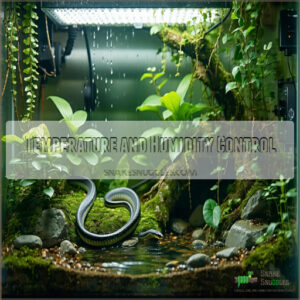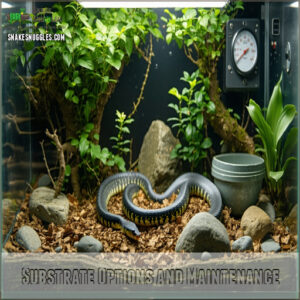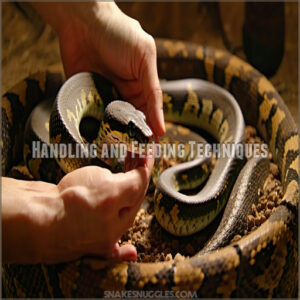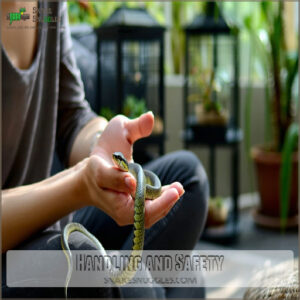This site is supported by our readers. We may earn a commission, at no cost to you, if you purchase through links.
 You’ll find that snake ownership basics start with selecting the right species for your experience level.
You’ll find that snake ownership basics start with selecting the right species for your experience level.
Like choosing a dance partner, you’ll want a snake whose temperament matches yours.
Set up a secure enclosure with proper temperature zones, ventilation, and hiding spots – think of it as creating your snake’s perfect retreat.
You’ll need to maintain consistent feeding schedules, typically every 1-2 weeks, with appropriately sized prey.
Regular health checks and careful handling techniques keep both you and your serpentine friend safe.
From specialized substrate choices to humidity control, there’s an art to creating your snake’s ideal habitat.
Table Of Contents
- Key Takeaways
- Choosing Pet Snakes
- Snake Housing Needs
- Feeding Snake Pets
- Snake Health Care
- Handling and Safety
- Frequently Asked Questions (FAQs)
- What do I need to know before owning a snake?
- What are the requirements to own a snake?
- Can snakes become attached to their owner?
- What is the best snake for a first time snake owner?
- How long do snakes live in captivity?
- Can snakes recognize or bond with their owners?
- Do snakes need company from other snakes?
- What to do when moving house with snakes?
- Are snakes safe around other household pets?
- Conclusion
Key Takeaways
- You’ll need to match your snake species to your experience level – corn snakes and ball pythons are ideal for beginners due to their docile nature and straightforward care requirements.
- You’ll want to create a secure enclosure with proper temperature zones (70-85°F general area, 100°F+ basking spot), adequate ventilation, and multiple hiding spots to keep your snake comfortable and healthy.
- You’ll have to maintain consistent feeding schedules (every 1-2 weeks) using appropriately sized prey (about 10% of snake’s body weight), preferably using frozen-thawed food to avoid the risks associated with live prey.
- You’ll need to commit to long-term care, as pet snakes can live 15-30 years and require regular health checks, proper handling techniques, and specific humidity levels based on their species.
Choosing Pet Snakes
When choosing a pet snake, focus on species that match your experience level and commitment. Research your options carefully, considering factors like size, temperament, and specific care requirements.
Snake Species Selection
When picking a pet snake, research species thoroughly.
Snake breeds vary in size, temperament, and habitat needs.
Some, like venomous types, are poor choices for beginners.
Opt for captive-bred snakes with diverse morphs, as they’re healthier and ethically raised.
Match habitat requirements to your lifestyle, ensuring your chosen snake species thrives with proper care and attention.
Understanding pet snake breeds is essential for making an informed decision about the type of snake to keep as a pet.
Best Snakes for Beginners
For a beginner snake owner, a few snake breeds stand out: corn snakes, ball pythons, and king snakes.
These beginner snakes are known for their calm behavior, manageable size, and straightforward care essentials.
Stick to captive-bred pets for easier handling and fewer vet expenses.
They’re affordable, adapt well to captivity, and provide a solid foundation for learning snake breeding and care.
Legal Considerations for Owners
Before bringing a snake home, check ownership laws and permit requirements in your area.
Regulatory compliance guarantees you’re respecting animal rights and avoiding liability concerns.
Some species are restricted or require licenses, research thoroughly—snake laws can vary widely even in the same country.
For further guidance on responsible ownership, consult this comprehensive care guide.
Legal considerations keep pet ownership stress-free and protect both you and your scaly companion, ensuring a positive experience with regulatory compliance and animal rights.
Tank Size and Requirements
Once legalities are sorted, sizing your snake enclosure is next.
A tank’s length should match your snake’s size, with adequate depth for movement, and verify that space requirements meet their growth—snakes need room to stretch.
The ventilation systems keep air healthy, while humidity levels stabilize shedding cycles.
The right snake tank balances humidity, temperature, and substrate for comfort.
Snake Housing Needs
Providing a proper enclosure for your snake is essential for its health and well-being.
You’ll need to take into account factors like size, materials, temperature, and humidity to create a safe and comfortable habitat.
Enclosure Types and Materials
Choosing a snake species is exciting, but the right snake enclosure matters just as much! A great snake tank balances size, security, and proper materials.
When setting up a snake habitat, considering a suitable snake tank enclosure is essential for the snake’s health.
- PVC tanks are durable and perfect for humid habitats.
- Glass terrariums work well for visibility but need proper ventilation systems.
- Pick escape-proof lids, ensuring your snake habitat feels safe and escape-proof.
Temperature and Humidity Control
Snake comfort starts with stable climate control.
Create thermal gradients with heat sources like a heat lamp, offering spots between 70–85°F and basking zones over 100°F.
Monitor humidity levels using a hygrometer; every species has unique needs.
For example, Milk Snakes thrive at 40–60% humidity.
Avoid temperature fluctuations to keep your snake stress-free and healthy.
Effective reptile care management is vital for maintaining ideal vivarium conditions.
Substrate Options and Maintenance
Picking the right snake substrate means balancing comfort and practicality.
Popular bedding materials like cypress mulch or aspen shavings help maintain proper moisture levels and humidity control.
Avoid cedar—it’s toxic to snakes.
Regular cleaning methods, like spot-cleaning waste and replacing dirty bedding, prevent odor and bacteria.
Keep an eye on temperature to guarantee the substrate stays cozy and functional, ensuring a proper environment through practicality.
Hiding Places and Climbing Structures
Snake hides aren’t just décor—they’re comfort zones.
Offering snake tunnels, hide boxes, and climbing rocks in your terrarium keeps your reptile content.
Provide vertical space and decorative logs for species that enjoy climbing.
These elements mimic a natural snake habitat and reduce stress.
- Use multiple hiding spots (warm and cool areas).
- Include snake-friendly climbing structures.
- Pick secure, easy-to-clean materials, which are essential for a reptile environment.
Feeding Snake Pets
Feeding your snake properly is essential for its health and well-being, so it’s important to understand its dietary needs and feeding schedule.
From choosing the right prey size to avoiding common mistakes, providing meals the right way guarantees your snake thrives.
Dietary Needs and Requirements
Feeding your snake is more than dropping prey into the enclosure—it’s about nutrient balance and meeting their carnivorous diet needs.
Focus on the right prey size for proper digestion and avoid unnecessary dietary supplements.
Frozen snake food offers safety and convenience while reducing risks that live prey pose.
A customized snake diet guarantees a healthy, thriving pet.
Understanding proper feeding techniques is vital for maintaining a snake’s overall health and well-being.
Prey Options and Feeding Frequency
Mastering prey selection starts with a simple choice: frozen-thawed food offers safer feeding than live prey.
You’ll need to adjust your feeding schedule based on your snake’s age and size, typically every 1-2 weeks.
Store frozen food properly in your freezer, and consider rodent alternatives like pre-killed chicks for larger species.
Match prey size to about 10% of your snake’s body weight for ideal nutrient balance.
Many snake owners rely on frozen snake options when selecting a nutritious diet for their pets.
Handling and Feeding Techniques
Now that you’ve got your feeding plan set, let’s talk about safe snake handling during meals.
You’ll want to master specific techniques for both handling and feeding to keep you and your snake comfortable.
Here’s what experienced keepers do:
- Use feeding tongs to offer prey, keeping your hands safely away
- Never handle your snake during or right after meals
- Feed in a separate container to prevent substrate ingestion
- Watch for feeding responses – coiled posture means they’re ready
- Time feedings when your snake is most active, usually dawn or dusk
This approach to snake feeding helps establish a routine while keeping safety in mind.
Plus, proper handling techniques during mealtimes help build trust between you and your scaly friend.
Common Feeding Mistakes to Avoid
Your snake’s health starts with knowing what not to do at mealtime.
Let’s look at the common pitfalls that can affect your snake’s wellbeing.
| Mistake | Impact on Snake Health |
|---|---|
| Live prey risks | Injuries from bites and scratches |
| Wrong prey size | Digestive issues and stress |
| Inconsistent schedule | Poor growth and nutrition |
Remember, frozen-thawed prey offers safe feeding techniques without the risks of live prey.
Match the prey size to your snake’s body width, and stick to your feeding schedule.
Snake Health Care
You’ll need to protect your snake’s health through regular check-ups and proper preventive care, just as you’d for any other beloved pet.
Your snake’s well-being depends on your ability to spot common health issues early and maintain a clean habitat, so let’s explore the essential aspects of snake healthcare that every owner should know.
Common Health Issues and Symptoms
Being a snake detective means spotting health issues early.
Regarding snake diseases and health problems, you’ll need to watch for key symptoms that signal trouble.
Respiratory problems often show up as wheezing or bubbles around the nose, while skin infections might appear as unusual scales or lesions.
- Open-mouth breathing or unusual sounds indicate respiratory infections
- Patches of loose or discolored scales suggest skin problems
- Tiny moving specks point to snake mites
- Swollen mouth areas could mean infectious stomatitis
- Lethargy and appetite loss warn of underlying illness
The provided list of symptoms helps in identifying potential health issues in snakes, making it a crucial tool for any snake owner.
Veterinary Care and Check-ups
Regular health exams with reptile specialists keep your scaly friend in top shape.
You’ll need annual examinations, though some snake vets recommend twice-yearly check-ups for early disease detection.
Initial check-ups involve blood work, fecal analysis, and diagnostic testing.
Look for ARAV-certified veterinary care providers who understand snake health to recognize potential issues early on.
Consider snake insurance to manage veterinary costs and unexpected emergency services expenses, and understand snake health through resources like snake health to stay informed.
Preventative Measures and Hygiene
With consistent check-ups in place, let’s focus on keeping your scaly friend healthy day-to-day.
Proper sanitation protocols aren’t just about spot-cleaning – they’re your first defense against disease.
You’ll want to deep-clean the enclosure monthly, wipe down surfaces weekly, and monitor humidity levels daily.
A solid cleaning schedule helps prevent parasites and infections, while proper hygiene practices guarantee your pet’s long-term health, through a well-planned cleaning schedule.
Signs of Illness and Emergency Care
Looking out for health issues early can save you from costly veterinary emergencies with your snake.
Watch closely for these warning signs that need immediate attention:
- Wheezing or bubbles around nostrils signal respiratory issues
- Unusual lumps or swelling might indicate snake parasites
- Refusing food for over a month (except during breeding season)
- Open-mouth breathing or discharge requires emergency response
Keep your vet’s number handy and start a health monitoring log.
Handling and Safety
You’ll discover that handling your pet snake safely requires a few essential skills, from reading their body language to using proper support techniques.
When you’re ready to handle your snake, you’ll need to maintain calm confidence while following key safety practices that protect both you and your scaly friend.
Snake Temperament and Behavior
Depending on your snake’s unique temperament, you’ll see varying behavioral patterns from bold curiosity to shy retreats.
While they might seem aloof, pet snakes can recognize their owners and even show distinct personality traits through their body language.
They’re not naturally aggressive creatures, but like any animal, they’ll defend themselves if they feel threatened, which is why understanding these social interaction cues helps build trust, and is key to developing a strong bond based on trust.
Safe Handling and Support Techniques
Support your snake like you’d hold a delicate flower in bloom, using gentle handling to build trust, letting your snake feel secure in your care.
Always use proper snake restraint techniques to keep both you and your serpentine friend safe.
- Start handling near the ground, supporting the snake’s body at multiple points
- Move slowly and confidently during snake handling sessions
- Practice support techniques until they become second nature, ensuring a safe and trusting environment for your snake, which is essential for successful snake handling.
Safety Precautions and Risk Awareness
Pet snake safety isn’t just about handling – it’s a complete risk assessment strategy.
You’ll need proper gear like snake hooks and gloves for protection against potential venomous snake bites.
Keep your yard clear of hiding spots, and install secure locks to prevent snake escapes.
Learn to read defensive signals, and always have emergency response plans ready, considering pet insurance options to help cover unexpected incidents, which can be part of a broader emergency response plan.
Mental Preparation and Long-term Commitment
Beyond safety measures, snake ownership demands a deep emotional investment that spans decades.
Your new friend might live 20-30 years, so you’ll need to factor in long-term care costs, housing stability, and regular vet visits.
Snake bonding takes time – they’re not instant cuddle buddies.
You’re signing up for a lifetime dedication that’ll shape your routines, travel plans, and even housing choices.
Understanding snake handling safety is essential for creating a secure environment for both you and your pet snake.
Frequently Asked Questions (FAQs)
What do I need to know before owning a snake?
You’ll need to take into account habitat setup, feeding requirements, species temperament, and local laws.
Research proper handling techniques, vet availability, and understand that snakes can live 15-30 years with proper care.
What are the requirements to own a snake?
You’ll want a secure enclosure matching your snake’s size, proper heating and lighting, fresh water access, appropriate substrate, hiding spots, plus knowledge of feeding schedules and local snake ownership laws.
Can snakes become attached to their owner?
Like a goldfish’s memory being better than myths suggest, snakes can recognize you but don’t form emotional bonds.
They’ll become comfortable with your presence and handling, making them seem friendlier over time.
What is the best snake for a first time snake owner?
Corn snakes and ball pythons make excellent first pets.
They’re docile, stay manageable in size, and don’t need complex care.
You’ll find them readily available and reasonably priced at reputable breeders or shops.
How long do snakes live in captivity?
You’ll find most pet snakes living between 10-30 years in captivity.
Ball pythons top the charts at 20-30 years, while garter snakes have shorter lifespans of 8-10 years with proper care.
Can snakes recognize or bond with their owners?
While your scaly friend isn’t likely to wag a tail in joy, snakes can learn to recognize you through scent and associate you with positive experiences like feeding and gentle handling.
They’ll show trust through calm behavior.
Do snakes need company from other snakes?
No, your snake doesn’t need snake buddies.
They’re naturally solitary creatures and prefer living alone.
Housing multiple snakes together can actually cause stress and potential fights, so it’s best to keep them separate.
What to do when moving house with snakes?
Moving your pet is like relocating precious cargo.
Transport them in secure, temperature-controlled containers.
Keep their routine stable before and after the move.
You’ll need fresh substrate and careful monitoring during relocation, ensuring a stable environment for your pet, similar to maintaining a stable routine.
Are snakes safe around other household pets?
Keep your snake and other pets separate, as interactions can be dangerous for both.
Even friendly pets like cats and dogs may see snakes as prey or threats.
Always supervise any necessary interactions.
Conclusion
Just as a journey of a thousand miles begins with a single step, your path to successful snake ownership starts with understanding the basics.
By mastering these snake ownership basics – from habitat setup to feeding routines – you’ll create a thriving environment for your serpentine companion.
Remember, each snake has unique needs and personalities, but with proper research, dedication, and consistent care, you’ll develop a rewarding bond with your pet that can last for many years.
















